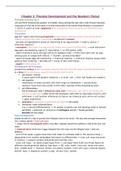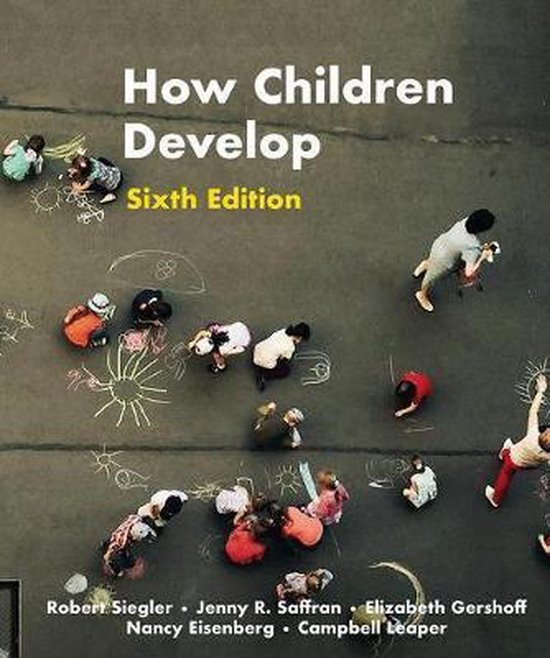1
Chapter 2: Prenatal Development and the Newborn Period
Prenatal Development
-4th cent BCE fundamental question of Aristotle: Does prenatal life start with a fully formed individual,
composed of a full set of tiny parts or do that many parts of the human body develop in succession?
→ 2nd is A. point of view: epigenesis = the emergence of new structures and functions during
development
Conception
egg cell + sperm cell (monocygots/gametes = reproductive cells that contain only half the genetic
material of all the other cells in the body) → produced in meiosis
- process of reproduction starts w/ launching of an egg (ovaries → tube to uterus →
chemical “beacon”
- conception = the union of an egg from the mother and a sperm from the father → next intercours
egg gets concepted by sperm (1 ejaculation = ca 500 sperm cells)
- sperm travels 6 hours through uterus to fallopian tube → most never get near an egg
(wrong tube or tangle with others) → “Darwin: survival of the fittest”
- sperm through egg cell membrane → chemical reaction → chemical reaction stops other
sperms from entering → tail falls off → nuclei of two cells merge
- zygote = fertilized egg cell
Development tal Processes
process from embryo (= the developing organism from the 3rd to 8th week of prenatal development)
to a fetus (= the developing organism from the 9th week to birth)
1. cell division =mitosis
2 equal parts (full genetic material) → 4 -8-16 - etc → from cell haufen to newborn
2. cell migration
movement of newly formed cells from origin to elsewhere → among them:
neurons move from the center to the outer reaches of the developing brain
3. cell differentiation
first all embryonic cells = embryonic stem cells = embryonic cells, which can develop into
any type of body cell → after some cell devisions cells start to specialize (much is still
unknown) → cell location influences its future via chemical and cell-to-cell contact
+ gene expression
4. apoptosis (= genetically programmed cell death) = cell suicide
5. Hormones: major influential factor
e.g. in sexual differentiation → no matter of genes can still develop male or female
genitalia → depends on presence of androgens (absent = female genitalia)
steroids are also major
Early Development
double its cells 2x a day in journey from fallopian tube to the womb - 4th day cells arrange themselves
into a hollow sphere = inner cell mass
→ stage where monozygotic twins most often originate (result from splitting in half of the inner cell
mass
→ fraternal twins result from 2 eggs released from the ovary into the fallopian tube + both are
fertilized
- end of first week: zygote (less than half make it) embeds itself in the uterine lining →
dependent from mother embedded ball starts to differentiate → inner cell mass becomes
in embryo + support system (placenta and amniotic sac)
- inner cell mass: 1st week single layer thick → 2nd week folds itself into three layers w/
different developmental destiny (top layer = NS, nails, teeth, inner eat, lense and outer
skin; middle layer = muscles, bones, circulatory system, inner skin layer, internal organs;
bottom layer = digestive system, lungs, urinary tract, glands
, 2
- week 3 U-shaped groove forms down the center of the top layer → creates the neural
tube = a groove formed in the top layer of differentiated cells in the embryo that eventually becomes
the brain and the spinal cord
- support system:
1. amniotic sac = transparent, fluid-filled membrane that surrounds and protects the fetus
(relatively even temperature and cushioning it against jointing)
2. placenta = support organ for the feurs; it keeps the circulatory system of the fetus and mother
separate, but semipermeable membrane permits the exchange of some materials between
them (oxygen and nutrients from mother to fetus, and carbon dioxide and waste products
from fetus to mother (90% of placenta cells are fetal)
3. umbilical cord = a tube containing the blood vessels connecting the fetus and placenta
Prenatal Development
- slower development as early development → head to bottom development
- cephalocaudal development = the pattern of growth in which areas near the head develop earlier
than areas farther from the head
- week 4: curved very tightly head and tail-like structure at other end are almost touching
→ can see heart and head also eye can be seen (evtl. also arm)
- 5 ½ weeks: mouth, nose and palate beginning to differentiate into sep structures
- week 8 1/2 : mouth and nose are fully formed
- week 9: extremely rapid brain growth + rudimentary eyes and ears + internal organs are present +
ribs, fingers and toes
- week 11: heart + basic adult structure → ribs and spines
- 5 months: lower body parts + external genitalia
- 18 weeks: very fine hair greasy coating protects + facial expressions
- 28 weeks: brain and lungs, eyes can open can move; periods of REM sleep
- last free month: triples in size; brain and lungs, capable of learning and behaviors begin to emerge
Fetal Experience and Behavior
a) Movement
5-6 week after conception: spontaneous
week 7: distinct patterns of movement; remarkably hiccups (burping reflex)
swallowing: fetus swallows amniotic fluid → most is excreted out into the amniotic
sac → tongue movements
- anticipated breathing: fetal breathing is initially (3rd trimester 1 “breath” per second)
b) Touch
observed grasping their umbilical cords but also rub their faces + sucking thumb (predictor of
handedness)
+ sensory apparatus in the inner ear (balance and movement) functions before birth
c) SIght
visual experience of fetus is minimal (minimal experience can be seen in 3rd trimester)
prenatal preference of top-heavy light patterns over bottom heavy ones
d) Taste
like sweet amniotic fluids more than others
- experiment w/ saccharine fluid injected into fluid
e) Smell
am flu take over odors of what mother’s meal
smell can be transmitted through liquid → contact of fluid w/ odor receptors when
“breathing”
phylogenetic continuity = the idea that because of our common evolutionary history, humans
share many characteristics, behaviors, and developmental processes w/ non-human animals,
especially mammals
→ rat washing nipples example
f) Hearing → plays large role in prenatal learning
, 3
prenatal environment is very noisy: blood flow, mother’s heartbeat, breathing, fetuses’ digestive
sounds (around uterus 70-90 decibels)
+ mother’s voice
+ last trimester: outer sounds and exp mother’s voice
Fetal Learning
- very much is learned in the womb in the last 3 months of pregnancy (after CNS is fully developed)
- infants remember specific prenatal auditory experiences that were presented via audio speakers
attached to mother’s abdomen
- more direct evidence: habituation → fetuses are bored when stimulus is presented over
and over
habituation = a simple form of learning that involves a decrease in response to repeated or continued
stimulation → at about 30 months of fetal age: show responses of habituation (visual and
auditory)
dishabituation = the introduction of a new stimulus rekindles interested following habituation to a
repeated stimulus
- test of fetuses reactions to recordings of the mother’s voices (↗ Pulse when mother
talks; ↘ Pulse when others) → show recognition of mother’s voice
- newborns remember much about fetal experience: voice, like same food as mother ate during
pregnancy, remember stories they heard in their womb; recognition of scents of mothers amniotic
scent and tastes
→ fetal brain is unlikely to be sufficiently developed to process much about languages
meaning → fetus learns about general sounds not specific content
Hazards to Prenatal Development
- moat dire and common misfortune of prenatal developmental errors is spontaneous abotion (mostly
occurs before the woman knows she’s pregnant) → because of major early defects
(missing or extra chromosome) → 25-50% experience miscariage, approx 1% recurrent
miscarriages
→ other factors: environmental = Teratogens
Teratogens = an external agent that can cause damage or death during prenatal development
- most only damage during the sensitive period = the period of time during which a developing
organism is most sensitive to the effect of external factors
- organs are most vulnerable during the time when their basic structures are formed
- most dramatic illusion: timing of the drug thalidomide in the 1960s (most extreme effects during
week 4.5 and 12.5, most prevalent time of morning sickness) besides the timing also dose-response
relation = a relation
- Teratogens mostly occur in combination → hard to separate the effects
, 4
→ multiple risk factors present: cumulative impact
- negative effects of prenatal exp may not be immediately evident → fetal programming
= “program the physiological set points that will govern physiology in adulthood”
→ evidence: Hunger in the Netherlands during WW2 in german winter
- individual susceptibility differences of teratogens
- problem: sleeper effects: effects might not be visible for over years
a) Drugs
both illegal and legal drugs can have an impact on prenatal development
- Antidepressants: can reduce the risk for postpartum depression → inconclusive
evidence for harmfulness of antidepressants
→ potential solution: use of non-pharmaceutical treatments for depression (CBT,
BT and Mindfulness-based CT)
- Opioides: prescribed opioid medications and use of illicit opioids → problem
→ designed to mimic NTs
- can lead to NAS (neonatal abstinence syndrome) = drug withdrawal seen when
fetuses exposed to opioids in the womb → extreme increase (esp in rural areas)
→ common effects: low birth weight, breathing and feeding problems & seizures
- Marijuana: commonly used in women during reproductive age
→ inconclusive because many users of marijuana also smoke cigarettes or use alk
→ but it can have devastating effects if used together w/ opioids, alk or cigarettes
- Cigarette Smoking
→ less oxygen for mother AND fetus → fewer breathing movement during smoking
of mother
- developmental consequences: slow growth and low birth weight + increase of sudden child
death syndrome + depends on dose-response relationship
→ highly reliable sources
- Alcohol
- can cause fetal brain injury + generally considered the most preventable cause
- alc consumption during pregnancy depends on cultural and demographic factors
- direct (placenta) and indirect (amniotic-fluid) exposure to alkohol → alc
concentration of in blood of mother and fetus equalize
→ Fetal alcohol spectrum disorder (FASD) = The harmful effects of maternal alcohol
consumption on a developing fetus. Fetal alcohol syndrome (FAS) involves a range of effects,
including facial deformities, intellectual disabilities, attention problems, hyperactivity and other
defects. Fetal alcohol effects (FAE) is a term used for individuals who show some, but not all,
of the standard effects as FAS
- moderate drinking → still long- and short-term effects
b) Environmental Pollutants
- toxic metals, synthetic hormones, plastics, pesticides and herbicides →
teratogens
- can have severe side effects ( high fish → small head; fossils in the air → low
birth weight, neurotoxicity and disproportionately high in low SES
→ dose-response relationship → higher = more miscarriage, preterm birth and low
birth rate
Maternal factors
mother = most immediate environment → characteristics affect prenatal development
a) Age
- mother 15 or younger → baby 2-3x more likely to die in 1st year of life than of
women of age 23-29 (birth rate for teens is declining)
- higher age is also concerning (30s/40s): conception till this age includes risk factors + dose-
response relationship
→ higher risk for ASD when parents are older





